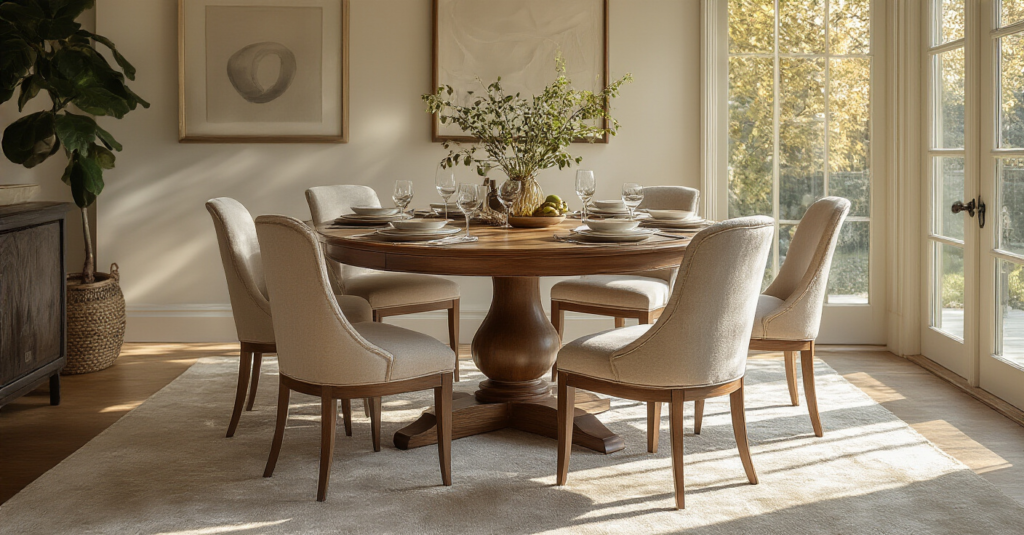You know what people always ask me? “Jasmine, how do I bring that rich, warm, Indian vibe into my home without it looking like a chaotic museum?” They’ve seen the stunning colors in my designs, the intricate patterns, the beautiful artisanal pieces, and they want a slice of that joy. But they live in a modern apartment, not a haveli in Jaipur. They’re afraid of getting it wrong, of it all being too much.
I get it. You see these glorious, maximalist rooms on Pinterest and think, “That’s beautiful, but I have kids/a small space/a minimalist partner.” So you default to gray. And your dining room, the place meant for connection and celebration, ends up feeling a little… bland. Forget that. Let’s talk about how to do this the right way. It’s not about copying a look; it’s about weaving in soul. It’s about telling your story, one beautiful object at a time.
The noise is all the design rules that say you must have a matching set of chairs, or that bold colors make a room feel small. That’s just fear talking. What actually matters is balance, texture, and light. A space that feels layered, collected, and deeply, personally you. I once had a client who inherited her grandmother’s heavy, ornately carved teakwood swing. She was going to sell it because it “didn’t fit” her modern condo. I almost cried! We hung it in her dining area, draped it with a simple linen throw, and it became the most magical, talked-about feature in her home. It’s not about throwing everything out and starting over. It’s about knowing what to keep, what to treasure, and how to let it shine.
Here are the shortcuts I wish someone had given me years ago—the real ways to create a dining room that’s vibrant, functional, and full of life.
Laying the Foundation: Strategic Planning & Purpose
Before you even think about that sapphire blue paint you’ve been eyeing, we need to lay the groundwork. This is the part everyone wants to skip, but it’s the secret sauce. It’s what separates a room that’s just decorated from one that’s truly designed. It’s where we make the plan, so the magic can unfold without chaos.
1. Define Your Dining Room’s Primary Function and Usage
First things first: what is this room really for? Sure, you’ll eat here. But will it also be where the kids do homework, where you have long, loud family dinners that stretch for hours, where you host Diwali parties with friends spilling out into the living room? Is it where you sit alone with your morning chai and a newspaper? Get honest about this. The problem with most dining rooms is they are designed for a fantasy life—one of formal, three-course dinners that happens twice a year.
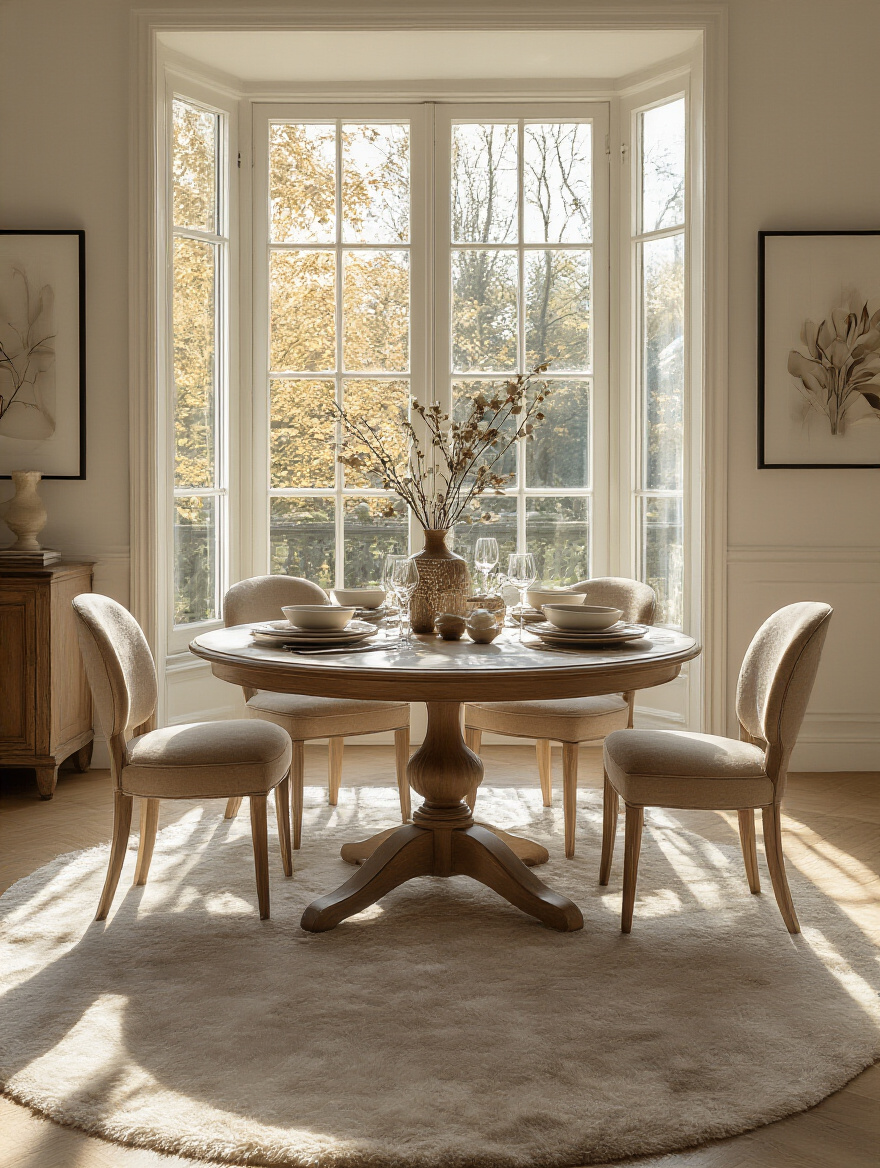
Design for the life you actually live. If your table is always a dumping ground for mail and keys, you don’t have a clutter problem—you have a design problem. It means you need a beautiful, designated spot for those things, like a small carved console table or a stunning brass bowl by the door. I had a family in a Mumbai apartment who needed a space for meals, homework, and their weekly puja. We designed a long, narrow table against a wall with a beautiful banquette, and at one end, a marble-topped credenza that held their mandir. The space worked for every part of their life, not just dinnertime.
With that clarity, you can start dreaming about the look and feel.
2. Choose a Cohesive Design Style for a Unified Look
Okay, “cohesive design style” sounds so formal, doesn’t it? Let’s call it your vibe. Are you going for “Jaipur palace meets modern loft” or “Calm coastal retreat with a touch of Goan spice”? Everyone thinks blending Indian design with contemporary means chaos, but it doesn’t. The trick is to choose a dominant style and then layer in the other as an accent. You can have clean, modern lines for your main furniture, then bring in the soul with textiles, art, and one-of-a-kind pieces.

My secret is to think in terms of 80/20. Eighty percent of the room can be calm and contemporary—think a simple table, clean walls, maybe a neutral sofa in an open-plan space. Then, the other twenty percent is where you let the vibrant spirit of India sing. A stunning, oversized Pichwai painting on the wall, a set of dining chairs upholstered in a bold Ikat fabric, a hand-knotted Kashmiri rug that grounds the whole space. This creates balance. It feels intentional and curated, not like an explosion in a gift shop.
Once you’ve got your vibe in mind, it’s time for the least glamorous—but most important—step of all.
3. Accurately Measure Room Dimensions for Optimal Furniture Placement
Please, please, I beg you—measure your room. Then measure it again. I once watched a client fall in love with an absolutely breathtaking 8-seater Dining Table made from a single slab of reclaimed wood in a Jodhpur market. It was magnificent. It was also two inches too wide to fit through his apartment door. The heartbreak was real. So was the cost of shipping it back.
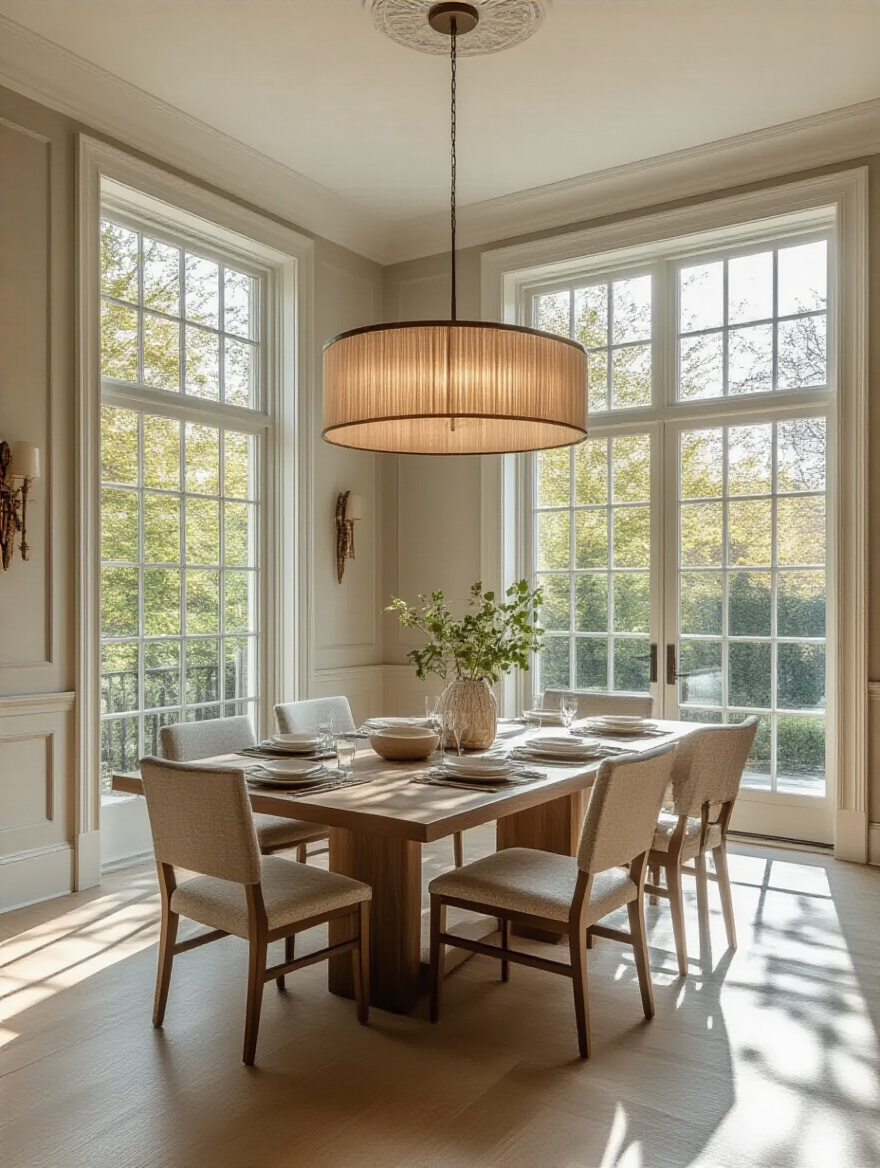
Get out a tape measure. Sketch the room. Mark where the doors are (and which way they swing!), where the windows are, and any weird corners. Then, here’s my never-fail trick: use painter’s tape to mark out the dimensions of the furniture you’re considering directly on the floor. Walk around your “ghost” table. Pull out your “ghost” chairs. Can you get to the kitchen easily? Does it feel cramped? This little trick will save you so much money and heartache. You will know, with certainty, if a piece is going to work.
Now that you know what physically fits, let’s talk about what financially fits.
4. Establish a Realistic Project Budget for Cost-Effective Design
Look, it’s easy to get carried away. You create a Pinterest board filled with marble inlay tables and silk curtains, and suddenly you’ve designed a room that costs more than a car. Let’s be real. A budget isn’t a creativity killer; it’s a framework that forces you to be creative. Decide what your “hero” piece is. The one thing you are willing to splurge on because it makes your heart sing. Maybe it’s a handcrafted dining table that will become a family heirloom, or a stunning chandelier that sets the whole mood.
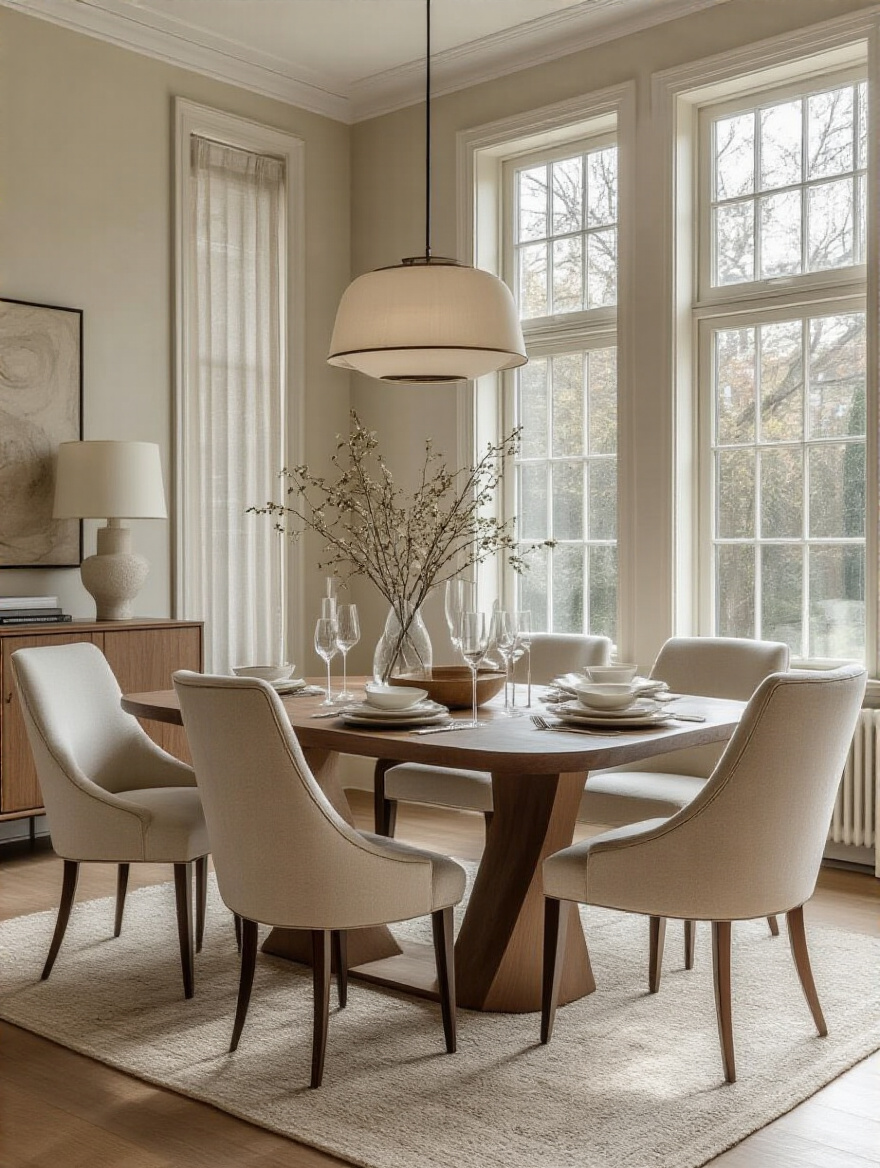
Then, you can be clever about the rest. For a client on a tight budget, we found a gorgeous, solid Sheesham wood table on a secondhand site. It was in perfect condition. That was our splurge. We then paired it with simple, modern chairs and put the money we saved into custom-made curtains from a beautiful block-printed fabric we found online. The end result looked incredibly luxe and personal. A budget just makes you a smarter, more resourceful designer. Don’t be afraid of it.
Your budget and your dream pieces are ready. It’s time to bring them together visually.
5. Create an Inspirational Mood Board to Visualize Your Vision
This is the fun part! A mood board is your project’s soul on paper (or on screen). But don’t just pin images of finished rooms. Get specific. Your mood board should be a feast for the senses. Of course, have pictures of furniture you love. But also add a close-up shot of the grain in Sheesham wood. Pin a picture of a vibrant Haldi ceremony to capture that perfect shade of auspicious, joyful yellow you want for your accent wall. Add images of textures—the nubby weave of a dhurrie rug, the smooth coolness of a marble tabletop, the intricate thread of zardozi embroidery.
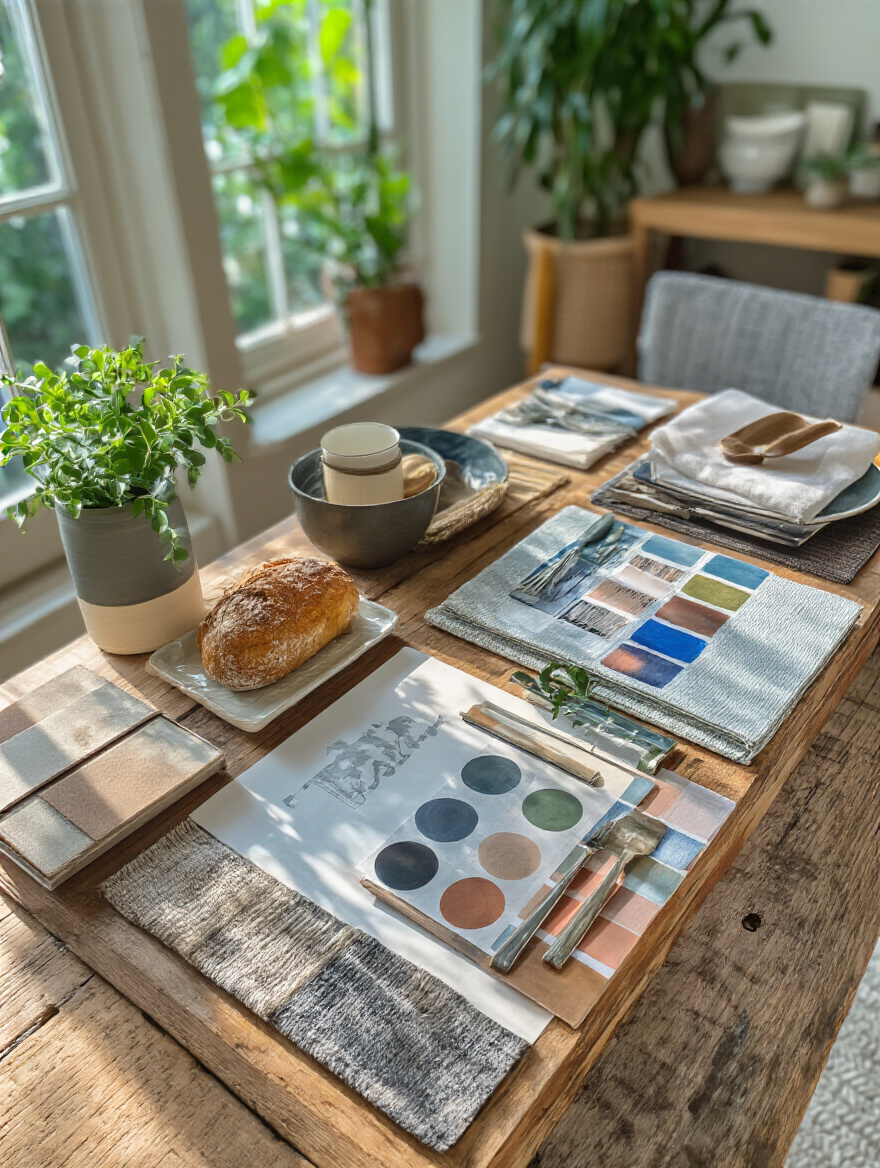
I always tell my clients to create a physical mood board if they can. Go to fabric stores and get swatches. Get paint chips. Find a fallen leaf or a spice that has the exact color you love. When you can touch and feel the elements together, you’ll know instantly if your vision is working. You’ll see if that emerald green velvet feels right next to that warm, rustic terracotta. It makes the whole vision tangible and helps you make decisions with so much more confidence.
Before you buy a single new thing, though, let’s shop in your own home first.
6. Assess Existing Elements for Seamless Integration or Removal
Most of us have pieces with history. Your grandmother’s brass lamp. The sideboard your parents got when they were first married. Your first instinct might be to get rid of them because they feel “dated.” Stop. These pieces are your home’s story. The goal isn’t to create a sterile showroom; it’s to create a space with soul. Look at each piece with fresh eyes.
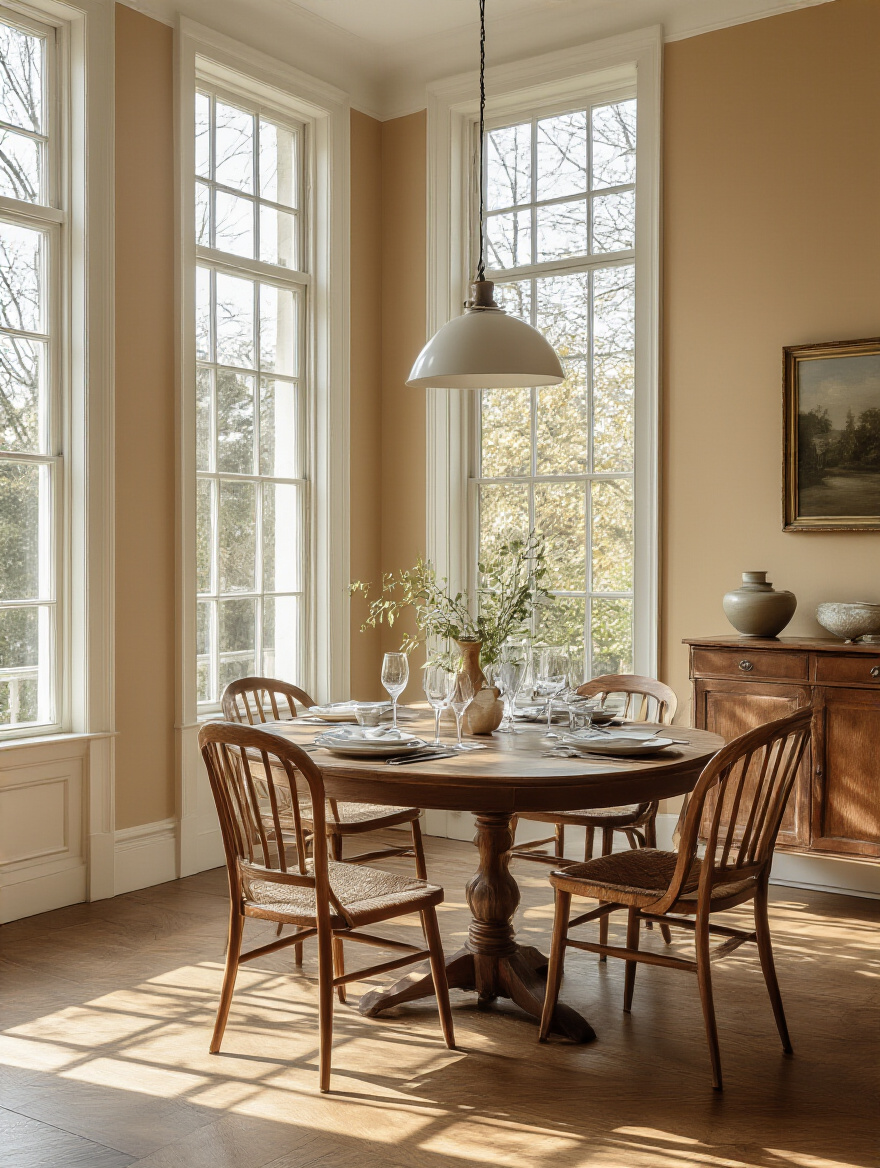
That dark, heavy-looking chair? Imagine it painted a brilliant peacock blue with a new cushion in a funky print. That old wooden chest? It could be the most stunning and unique buffet, perfect for storing your table linens. I had a client with a set of mismatched, colonial-era dining chairs that felt clunky and brown. We painted each one a different, vibrant jewel tone—ruby, emerald, sapphire, topaz—and suddenly, they were a whimsical, joyful collection that became the life of the room. It’s all about reimagining, not replacing.
Core Elements: Furniture Selection & Smart Layouts
Alright, the foundation is set. Now we get to the heart of the matter—the pieces that will host your meals, your conversations, and your life. This is about choosing furniture that is not only beautiful but also comfortable, practical, and perfectly scaled for your space.
7. Select the Right Dining Table Size for Guest Comfort
The single biggest mistake people make is buying a table that’s too big or too small. A huge table in a small room feels like an elephant in a closet, and a tiny table in a vast room feels lost and lonely. The key is to leave about 3 feet (or 1 meter) of breathing room between the edge of your table and the walls or other furniture. This gives you enough space to pull out chairs and walk around without everyone having to squeeze by sideways.
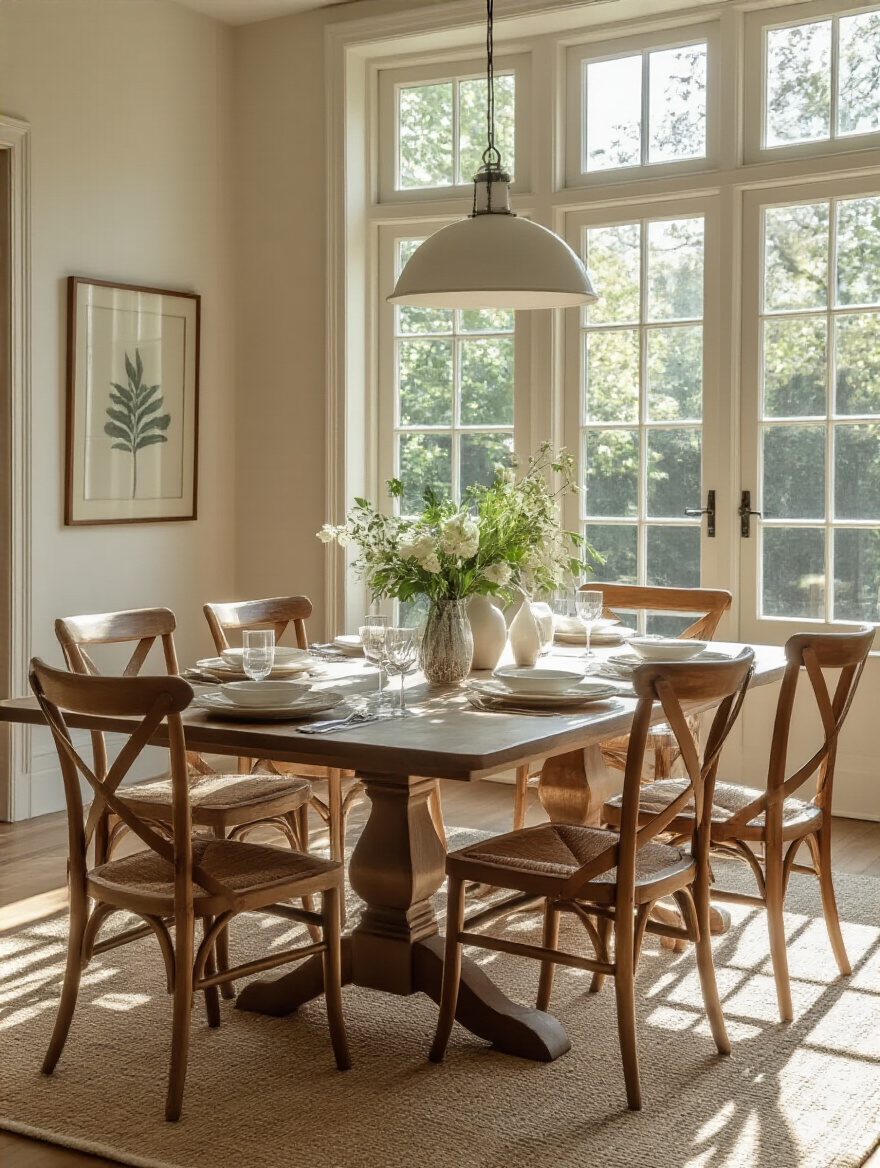
Think about how many people you usually have for dinner, not how many you host for that one big party a year. If it’s mostly your family of four, but you love hosting, an extendable table is your best friend. It stays compact for daily life but can rise to the occasion when you have a full house. It’s the most practical, space-saving solution, giving you the best of both worlds without sacrificing comfort day-to-day.
With the perfect size in mind, let’s talk shape.
8. Explore Table Shape Options for Improved Room Flow
The shape of your table can completely change the flow and feel of a room. Long, rectangular rooms were made for rectangular tables. They just work. But in a square or smaller space, a rectangular table can feel like a roadblock. Its sharp corners can create traffic jams and make the room feel tight.
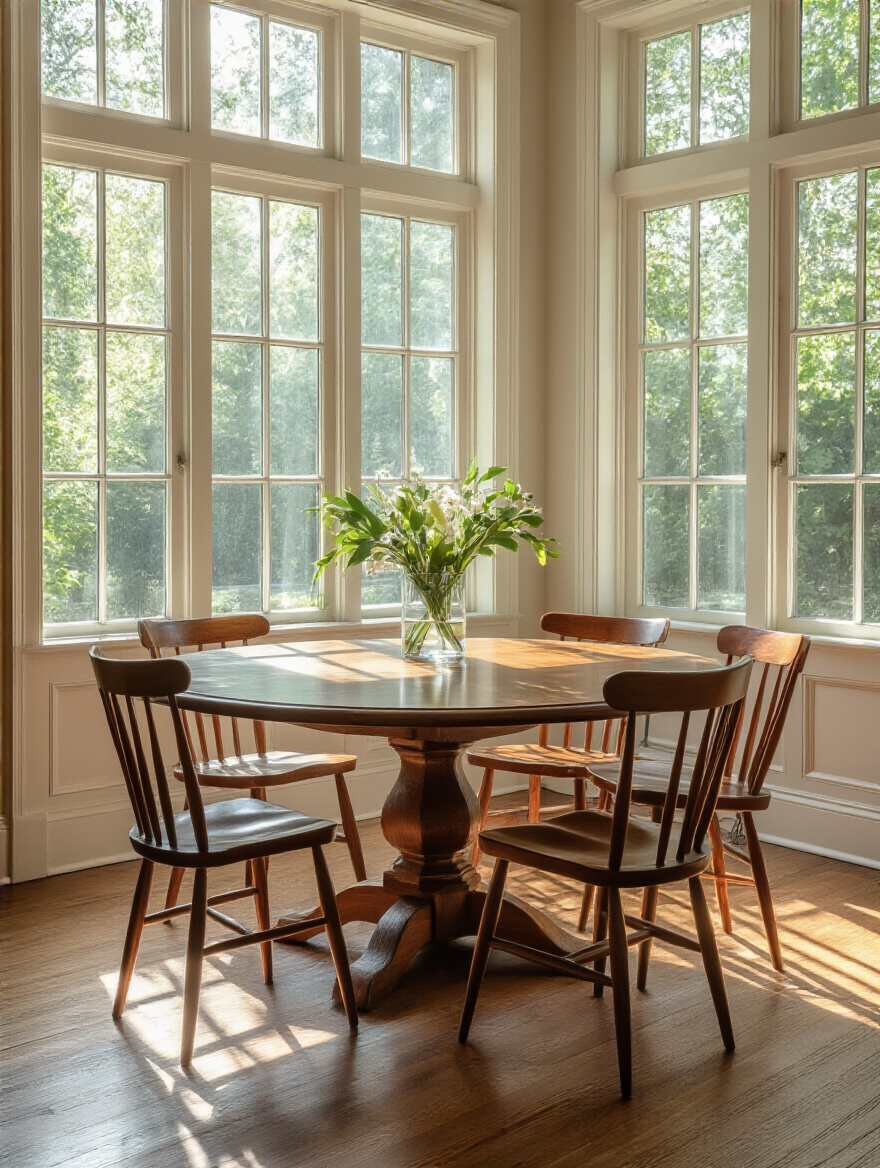
This is where a round table is magic. With no corners to bump into, it instantly improves flow and makes a space feel more open. Even better, everyone at a round table can see and talk to everyone else. There’s no “head of the table,” which makes for more lively, inclusive conversations—perfect for boisterous family gatherings! And if you need to squeeze in one extra person, it’s always easier at a round table. I love pedestal bases on round tables because they get rid of the legs, leaving even more room for chairs and feet.
Once you’ve found your perfect table, you need the perfect companions for it.
9. Choose Ergonomic, Comfortable Dining Chairs for Prolonged Enjoyment
I don’t care how beautiful a chair is. If it’s uncomfortable, it’s useless. A dining chair’s job is to encourage you to linger, to have another cup of chai, to share one more story. If your back is aching or your legs are falling asleep after ten minutes, people are going to flee the table. The goal is to make your guests so comfortable they lose track of time.
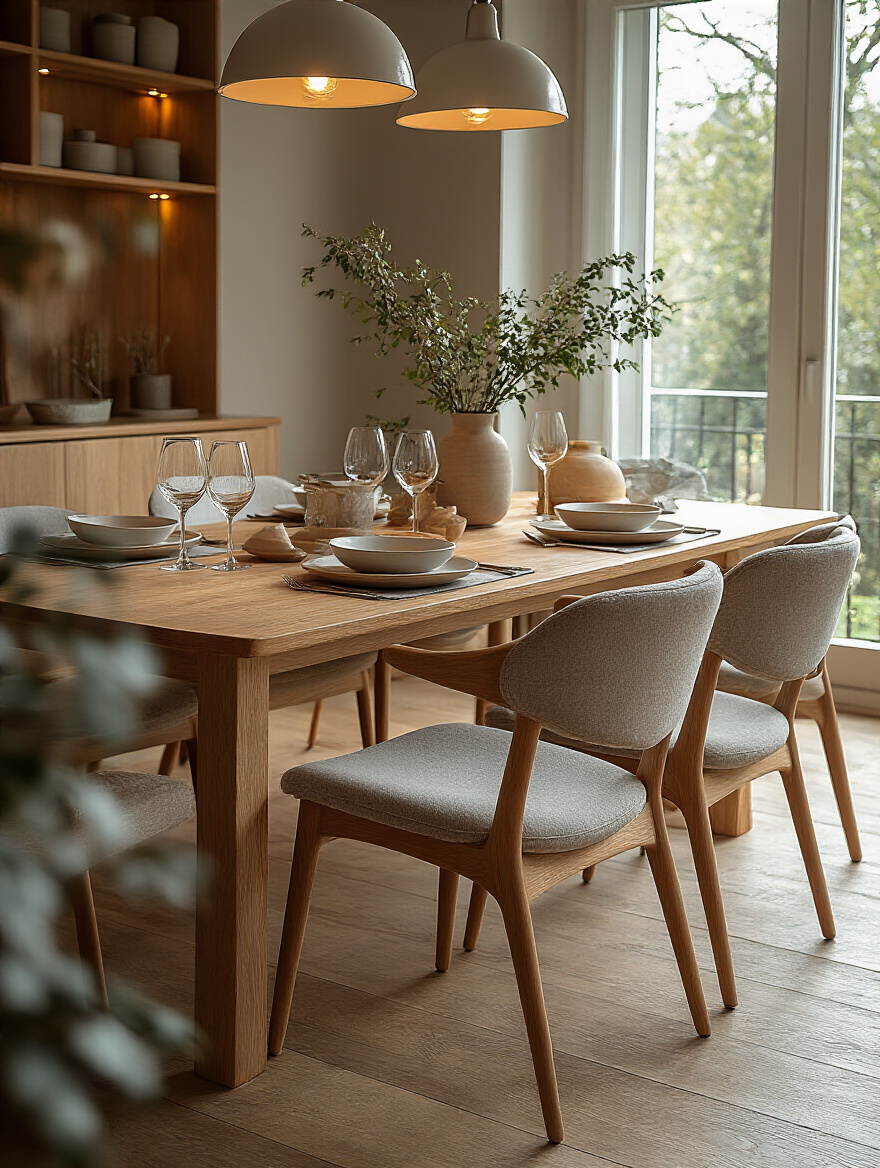
Don’t be afraid to mix and match! Who says all your chairs have to be the same? A collected look feels so much more personal and soulful. You could have two upholstered “captain’s chairs” at the ends and simpler wooden or cane-backed chairs along the sides. Or, find a set of vintage chairs and reupholster each one in a different, coordinating fabric from the same color family. It’s a fantastic way to bring in pattern and personality. And always, always try to sit in a chair before you buy it.
Now that everyone’s seated comfortably, where do you put all the stuff?
10. Integrate Smart Storage with Buffets or Built-in Cabinetry
A dining room needs storage for all the beautiful things that make dining a ritual—plates, linens, special serving dishes, candles. But you don’t need a generic, boring box. Think of your storage piece as another opportunity to add character. This is the perfect place for a one-of-a-kind find. I love using vintage Indian pieces like a Damchiya (a traditional dowry chest) or a rustic painted cabinet. They bring so much history and texture into a room.
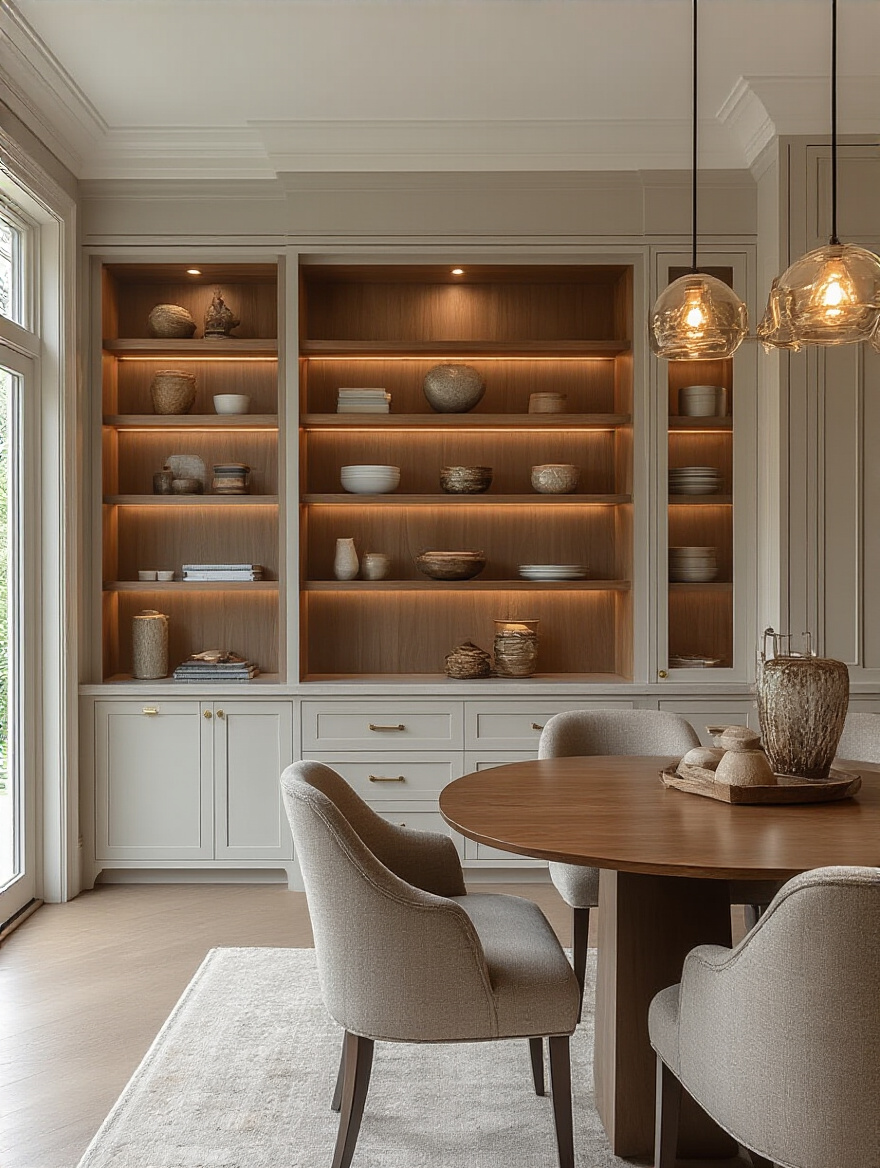
If you’re going for a more streamlined look, a long, low, modern credenza can look stunning. Look for one with interesting details, like carved doors or beautiful brass hardware. The top surface is your stage! It’s the perfect spot for a pair of beautiful lamps, a piece of art, and a tray for serving drinks. Built-in cabinetry is also a fantastic option, especially in smaller spaces, as it can be designed to blend seamlessly with the wall, maximizing storage without taking up precious floor space.
Storage sorted, let’s put it all together.
11. Strategically Plan Seating Arrangements to Maximize Space
Don’t just shove a table and chairs in the middle of the room and call it a day. Think about how you can use seating to your advantage. My favorite space-saving trick, especially for tight corners or narrow rooms, is a built-in banquette. It’s basically a bench built against the wall. You can push the table right up against it, which frees up a huge amount of floor space.
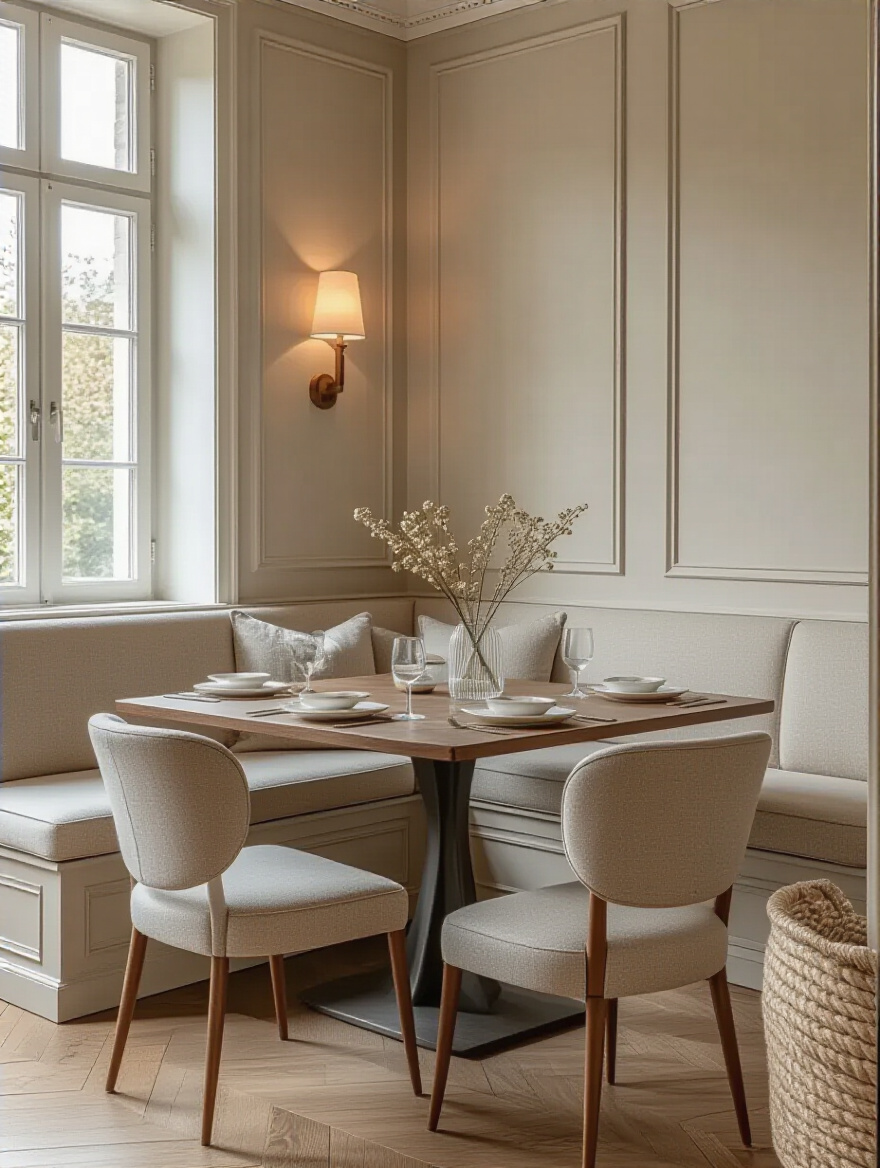
You can instantly seat more people on a banquette than you can with individual chairs in the same amount of space. Plus, it’s a brilliant opportunity for a splash of color and comfort. You can have a custom cushion made in a vibrant, durable fabric—a bold geometric, a traditional floral block print, or even a jewel-toned velvet. Add a pile of mis-matched cushions made from old silk saris or embroidered textiles, and you’ve created the coziest, most inviting nook in the entire house.
Now, to anchor this beautiful arrangement, we need to look down.
12. Define Your Dining Area Using a Well-Sized Area Rug
In an open-plan home, a rug is the single most effective way to say, “This is the dining area.” It creates a visual boundary, a zone dedicated to gathering and eating. But size is everything. The biggest mistake I see is a tiny rug that floats under the table like a postage stamp. It makes the whole room look small and disjointed.
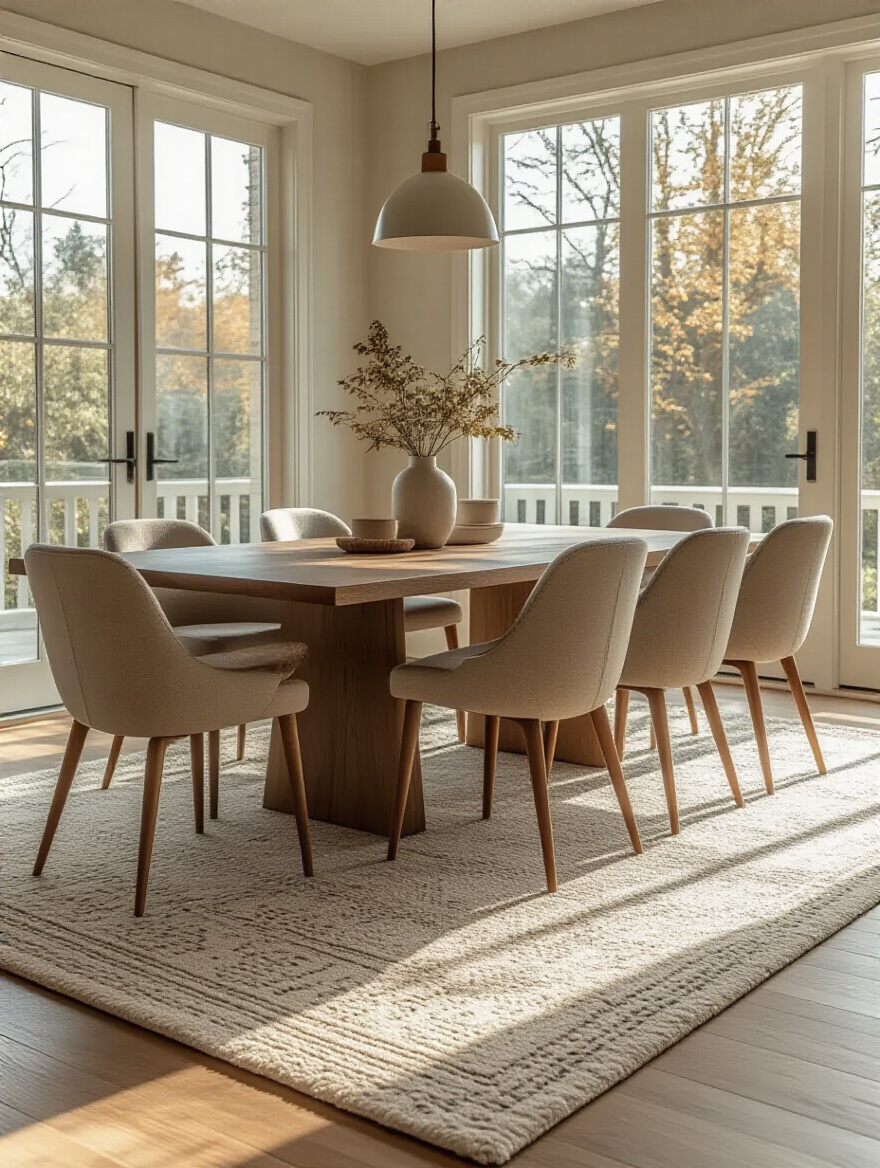
The rule is simple: all four legs of your chairs should still be on the rug, even when the chairs are pulled out from the table. Measure your table, add about 24-30 inches on all sides, and that’s the minimum size your rug should be. For a dining room, you want something durable and easy to clean. A flat-weave cotton Dhurrie from Rajasthan or a hard-wearing wool rug is perfect. They add incredible color and pattern but are practical enough to handle the occasional spill.
Illuminating Your Space: Lighting & Ambiance
If furniture is the body of the room, lighting is its soul. Good lighting can make a small room feel expansive, a simple meal feel like a feast, and a gathering feel magical. It is the most powerful tool you have to transform the entire mood of your space. Don’t treat it as an afterthought.
13. Install a Statement Chandelier for a Dramatic Focal Point
Every dining room deserves a piece of jewelry, and the chandelier is it. This is your chance to make a statement, to add a piece of art that also happens to light up. Forget boring, generic fixtures. Think bigger. Think bolder. I love using lanterns with colored glass or pierced metal that cast intricate, dancing patterns across the walls and ceiling. A beaded or shell chandelier can bring in a soft, organic texture.
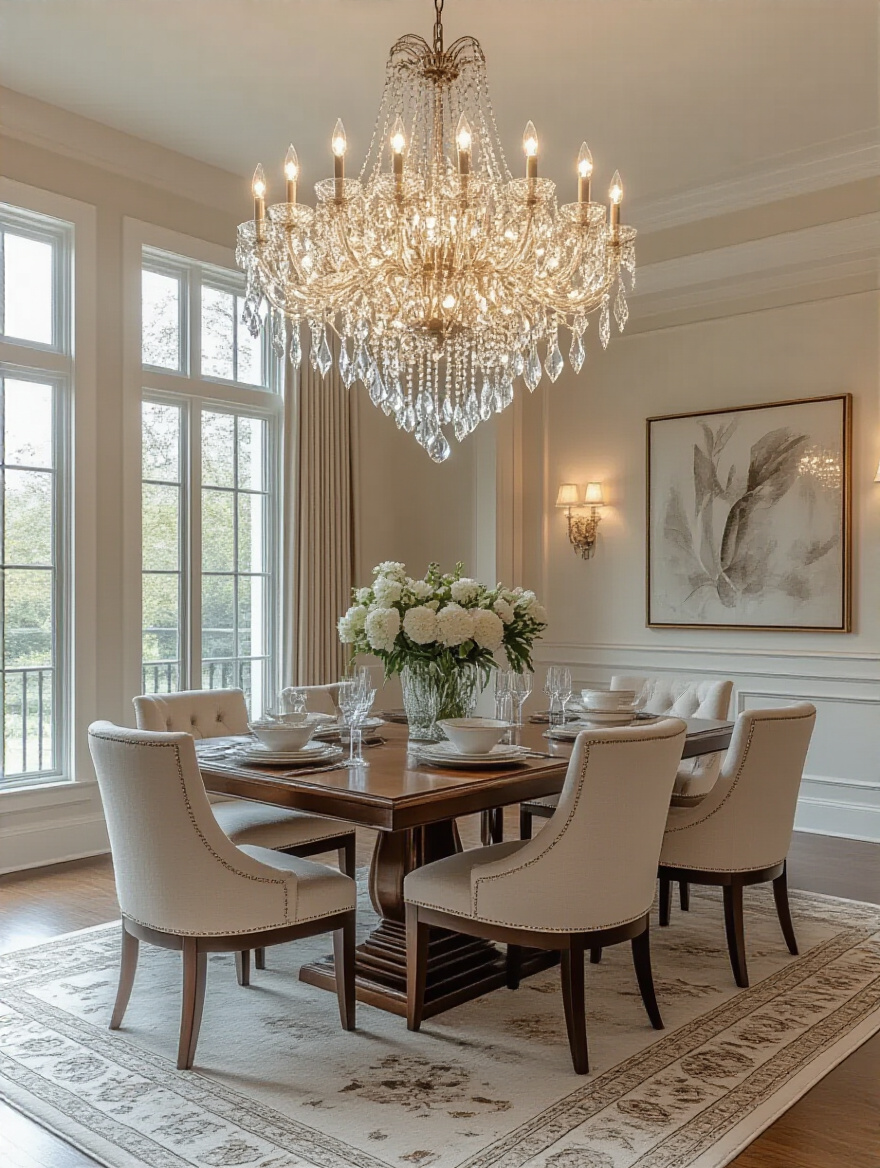
Don’t be afraid of scale. A slightly-too-large chandelier is a design statement; a too-small one just looks sad. As a general rule, the bottom of the fixture should hang about 30-36 inches above your tabletop. This is high enough that it doesn’t block anyone’s view but low enough that it feels connected to the table, creating a lovely, intimate pool of light for you and your guests.
Your beautiful chandelier needs a secret weapon to make it truly versatile.
14. Incorporate Dimmers for Adjustable Ambiance and Mood Control
A dimmer switch is the best ten dollars you will ever spend on your dining room. I am not kidding. It is non-negotiable. One room needs to have multiple personalities. It needs to be bright and cheerful for a sunny Sunday brunch, but it also needs to be soft, low, and romantic for an intimate dinner. A dimmer gives you that control with the simple turn of a knob.
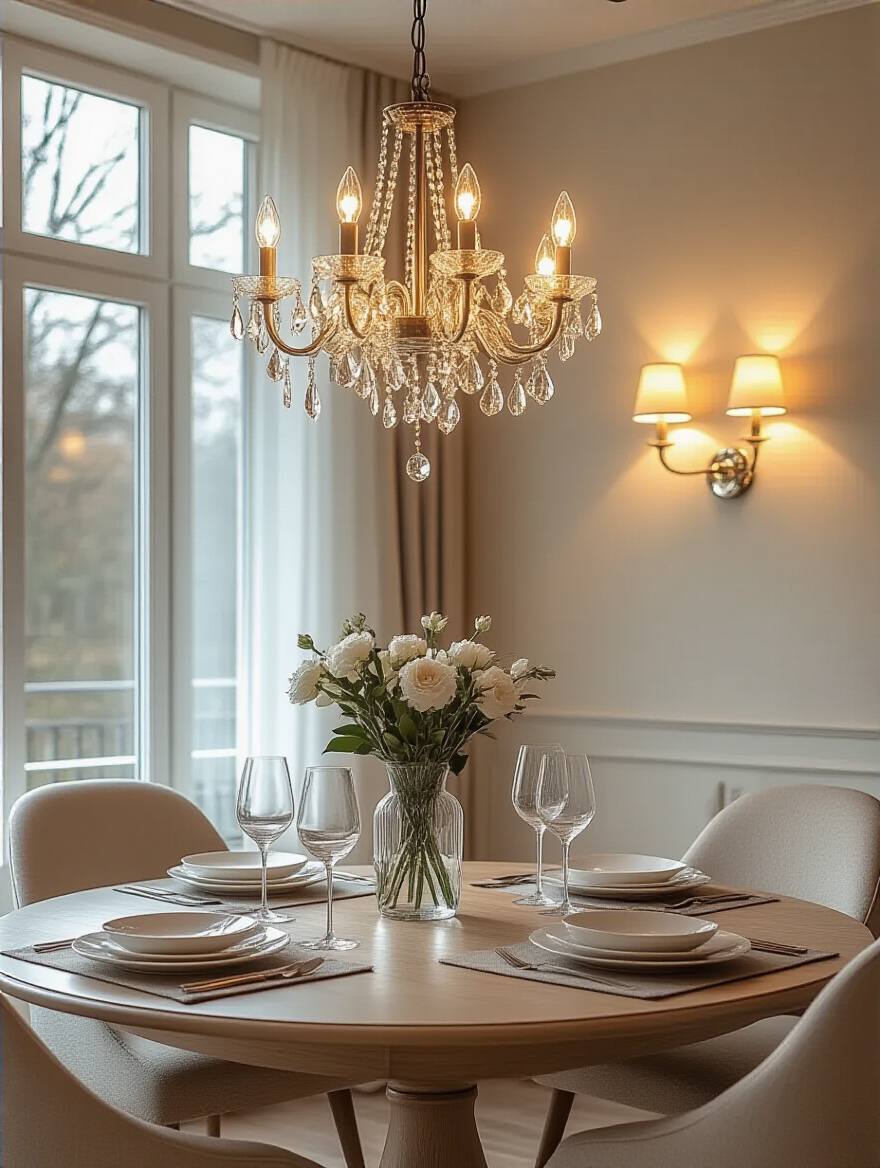
Without a dimmer, you’re stuck with one option: ON. And full-blast overhead lighting is rarely flattering for anyone or anything. Being able to dim the lights down to a soft glow instantly makes a space feel more sophisticated, more intimate, and more magical. Every single light in your dining room—from the chandelier to the wall sconces—should be on a dimmer. Trust me on this.
Beyond the main event, let’s add some supporting actors.
15. Add Accent or Task Lighting for Display or Buffet Areas
The chandelier provides the overall ambient light, but you need other, more focused light sources to really make the room come alive. Think about what you want to highlight. Do you have a beautiful piece of art hanging over your sideboard? A small, adjustable picture light mounted above it will turn it into a true focal point. Do you have a collection of beautiful glassware in a cabinet? Tiny puck lights installed inside the shelves will make them sparkle.
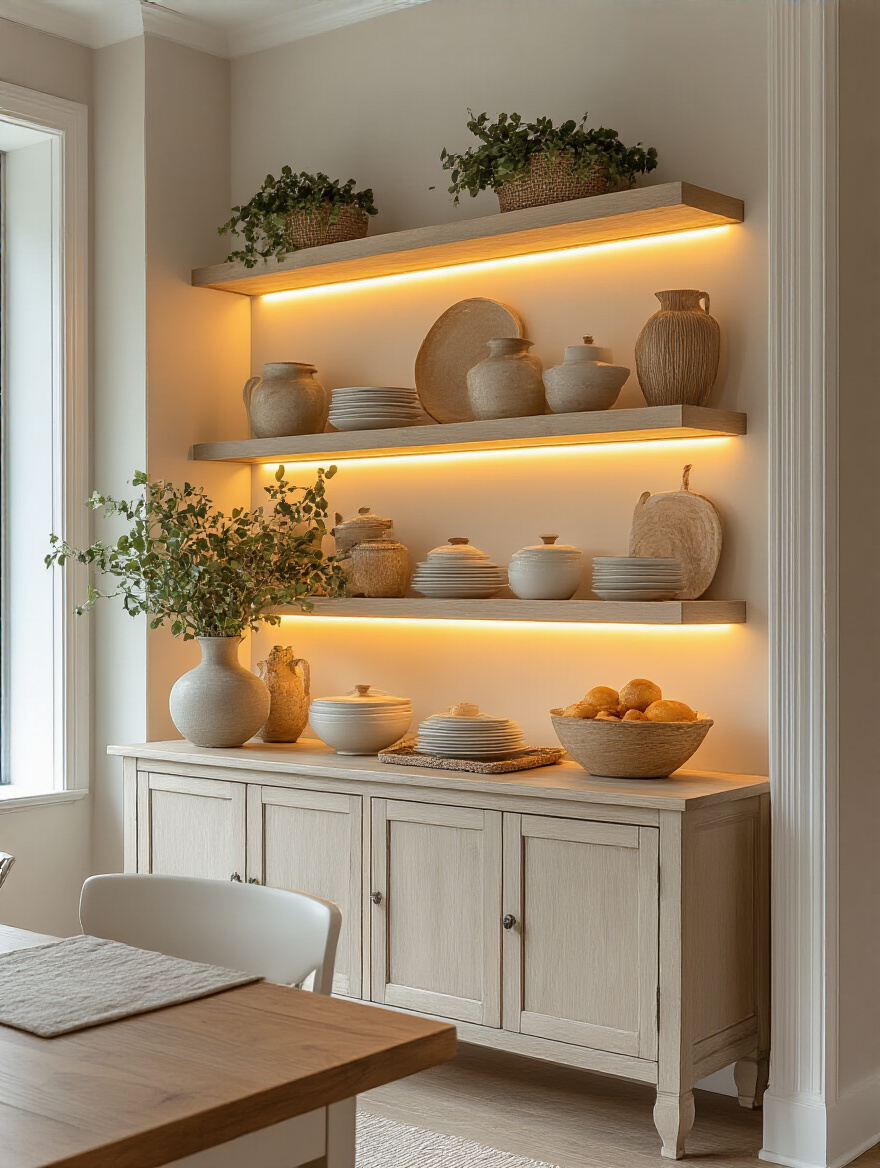
This isn’t just about looking pretty; it’s practical, too. A pair of small, elegant lamps on your buffet provides a soft, warm glow at serving height, which is much more welcoming than harsh overhead light when you’re setting out food. These extra little pools of light are what create depth and dimension, making the room feel layered and thoughtfully designed.
Speaking of layers, let’s keep building them.
16. Layer Lighting with Wall Sconces or Floor Lamps
Layering light is the secret to a professional-looking space. It means having light coming from different sources and at different heights. A chandelier is your overhead (ambient) layer. Lamps and picture lights are your mid-level (accent/task) layer. A floor lamp tucked into a corner adds another layer, washing a dark corner with a soft, upward glow that makes the whole room feel larger and more welcoming.
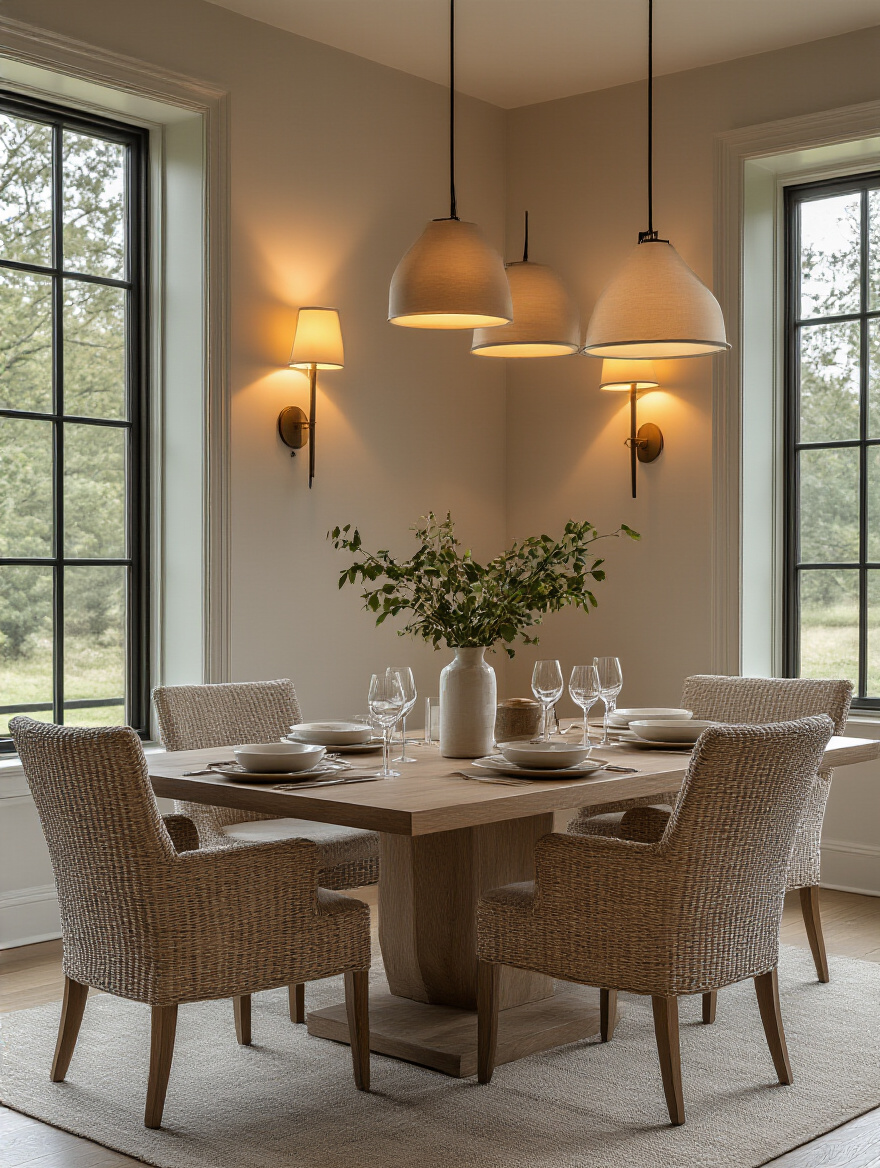
Wall sconces are brilliant. They can flank a beautiful mirror, a doorway, or a large piece of art, adding a touch of formal symmetry and elegance. They cast a lovely, gentle light that’s much more flattering to people’s faces than direct overhead light. By combining these different sources, you create a rich, dynamic environment that you can tailor to any mood or occasion.
For the final touch of magic, we turn to the oldest light source of all.
17. Enhance Ambiance Using Decorative Candles or LED Options
Nothing creates intimacy and a sense of occasion quite like the soft, flickering glow of candlelight. It makes everyone look beautiful and everything taste better. A collection of candles on the dining table is a must for any special meal. But don’t just stop at the table.
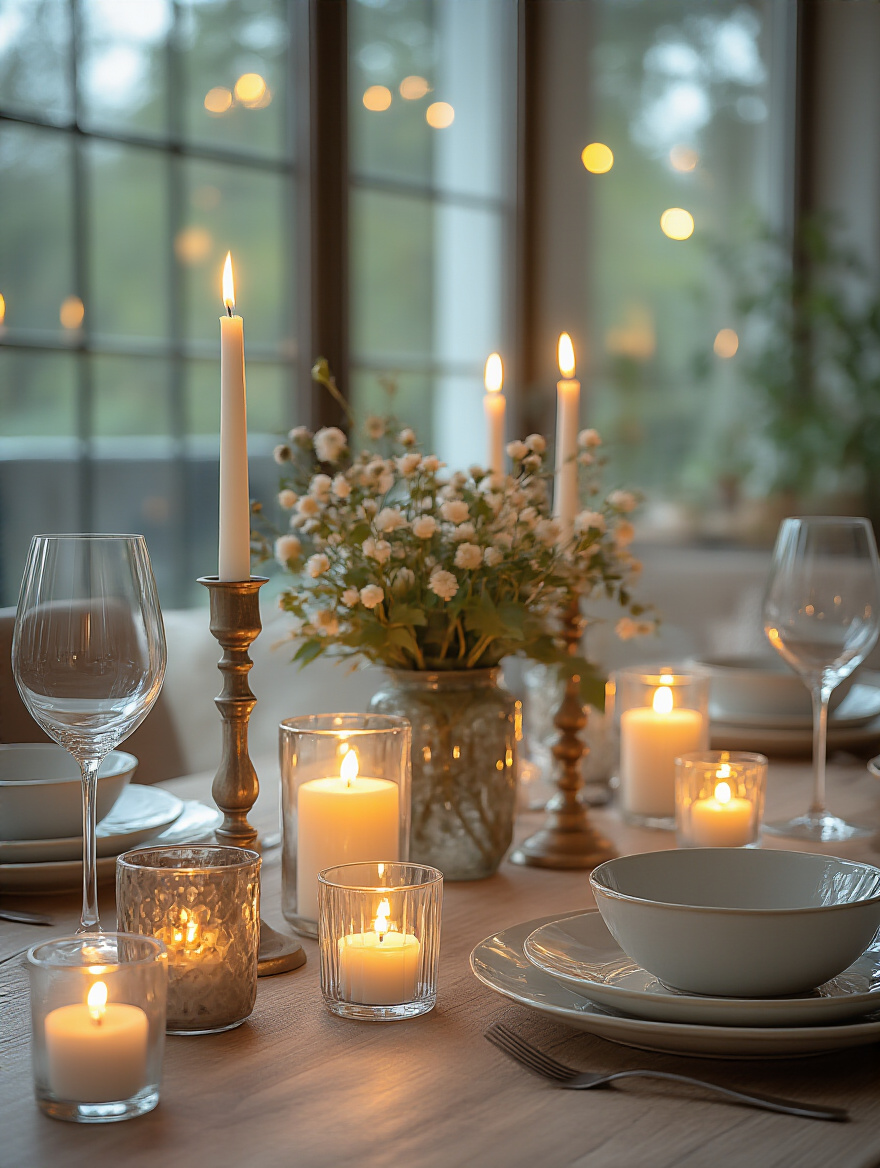
My favorite trick for creating a truly magical atmosphere is to place a grouping of candles on a sideboard or console. Or, for a classic Indian touch of hospitality, float a few tea lights and marigold petals in a brass urli (a beautiful, shallow bowl). The way the flame reflects in the water and the polished metal is just breathtaking. And if you’re worried about open flames, today’s high-quality flameless LED candles are incredibly realistic and give you the same warm glow without any of the stress.
Personalizing & Polishing: Decor & Finishing Touches
The room is furnished, the lighting is perfect. Now, it’s time to infuse it with your personality. These are the final layers that tell your story, that make the space uniquely yours. This is where the real fun begins.
18. Select Impactful wall art to Reflect Personal Style
Please don’t buy generic, mass-produced “art” just to fill a wall. A blank wall is better than a boring wall. Your dining room art should be something that you love, something that has meaning. It’s a conversation starter. It sets the tone for the entire room. Don’t be afraid to go big. One large, impactful piece of art will have a much greater effect than a scattering of small, timid ones.
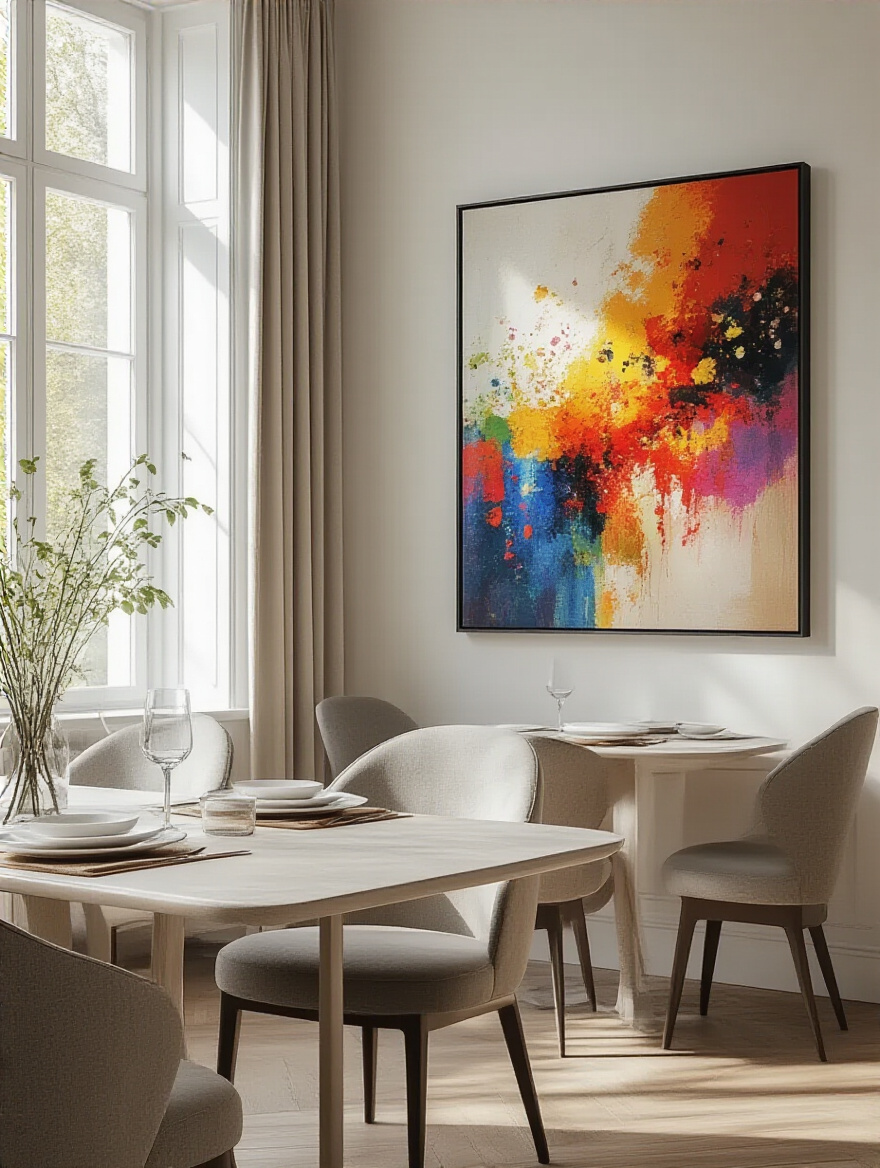
Think beyond a framed print. What about a stunning textile? A beautiful old Kantha quilt or an intricate Kalamkari panel, properly framed or hung from a rod, can be an incredible piece of art. I love using traditional Indian art forms like a vibrant Madhubani painting from Bihar or a delicate Warli painting from Maharashtra. These pieces are bursting with story and handmade soul. They instantly give a room history and depth.
From the walls, we move to the windows.
19. Choose Window Treatments for Light Control and Added Texture
Bare windows can feel cold and unfinished. Window treatments are the room’s final layer of clothing—they soften the hard edges and add crucial texture and warmth. In a dining room, you want to be able to control the light—diffusing harsh afternoon sun while still letting the light in.
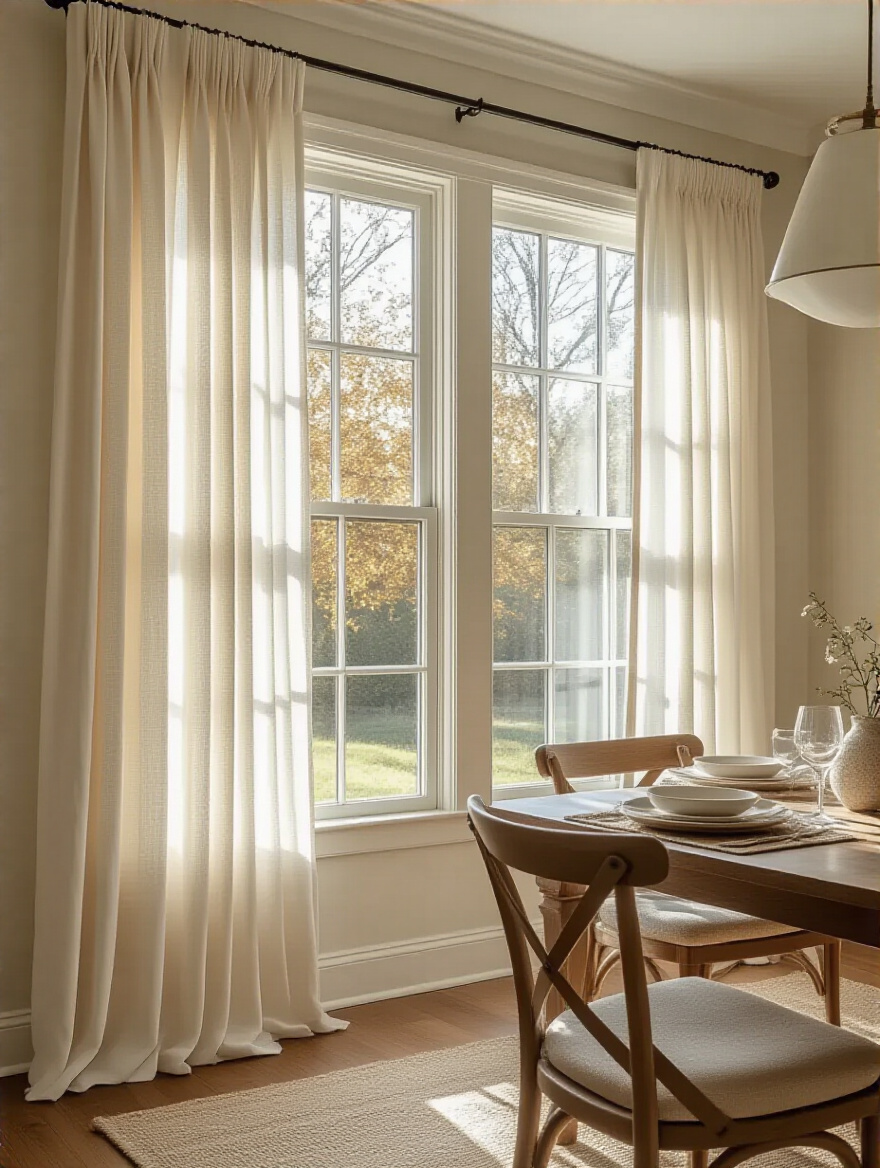
Sheer linen or cotton curtains are always a beautiful choice. They feel light and airy and provide a bit of privacy without blocking the view. For an extra touch of elegance, look for curtains with a subtle detail, like the delicate white-on-white Chikankari embroidery from Lucknow. If you want to add more color and pattern, beautiful hand-block-printed cotton curtains from Rajasthan are a fantastic way to do it. They feel so joyful and artisanal.
Next, a little designer trick to make the room feel bigger and brighter.
20. Strategically Place Mirrors to Visually Expand the Space
A mirror is the oldest trick in the book for a reason: it works. A large mirror can visually double the size of your space and bounce light all around the room, making it feel brighter and more open. The key is to be strategic about what it reflects. Position a mirror to reflect a beautiful window, your stunning chandelier, or a beloved piece of art. Never, ever place it where it will reflect clutter or an uninspiring view.

Instead of a plain, frameless mirror, think of it as another piece of art. Look for a mirror with a truly special frame. You can find incredible vintage pieces with carved wooden frames, or modern ones inlaid with intricate patterns of bone or mother-of-pearl from artisans in Jodhpur. A beautifully framed mirror adds an extra layer of texture and detail while working its space-expanding magic.
Now let’s bring that magic right to the center of the table.
21. Design Captivating Centerpieces for Year-Round Table Beauty
Your dining table shouldn’t sit empty and sad between meals. A beautiful centerpiece makes the room feel alive and ready for company at any moment. But it doesn’t have to be a fussy, formal flower arrangement that dies in three days. The secret to a great centerpiece is to create a versatile base that you can change with the seasons.
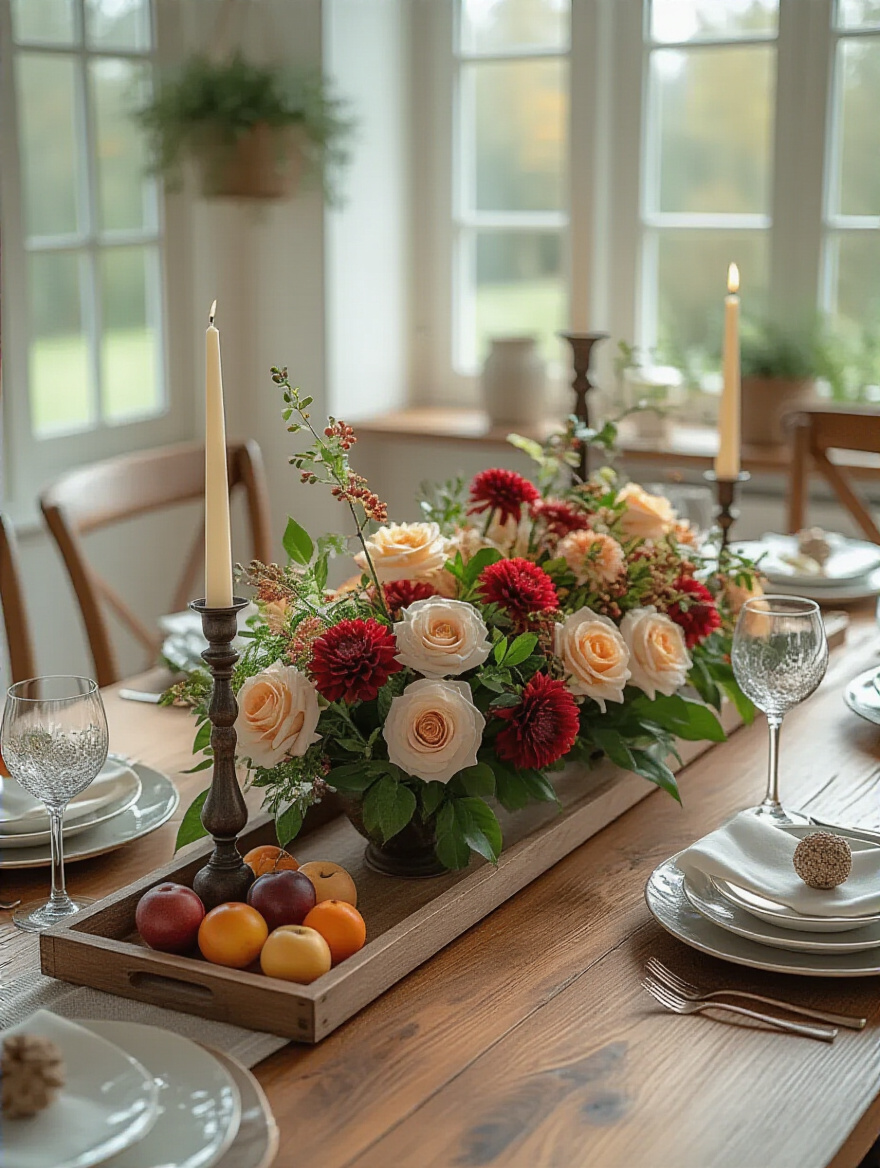
Start with a beautiful tray—maybe a long wooden one, a hammered brass platter, or a sleek marble slab. This is your foundation. On it, arrange a collection of objects with varying heights: a few beautiful candle holders, a small potted plant like a succulent, and a lovely ceramic or stone bowl. Then, you can easily swap out small elements: fill the bowl with seasonal fruit (lemons in summer, pomegranates in winter), tuck in a few sprigs of evergreen for the holidays, or add a single, beautiful flower from your garden. It keeps the table looking fresh and interesting with minimal effort.
Speaking of fresh, let’s bring more of the outside in.
22. Introduce Greenery and Plants for a Touch of Natural Life
Every single room needs something living in it. Plants breathe life, quite literally, into a space. They add a fresh, organic element that makes a room feel instantly calmer and more welcoming. You don’t need to turn your dining room into a jungle, but a few well-placed plants can make all the difference.
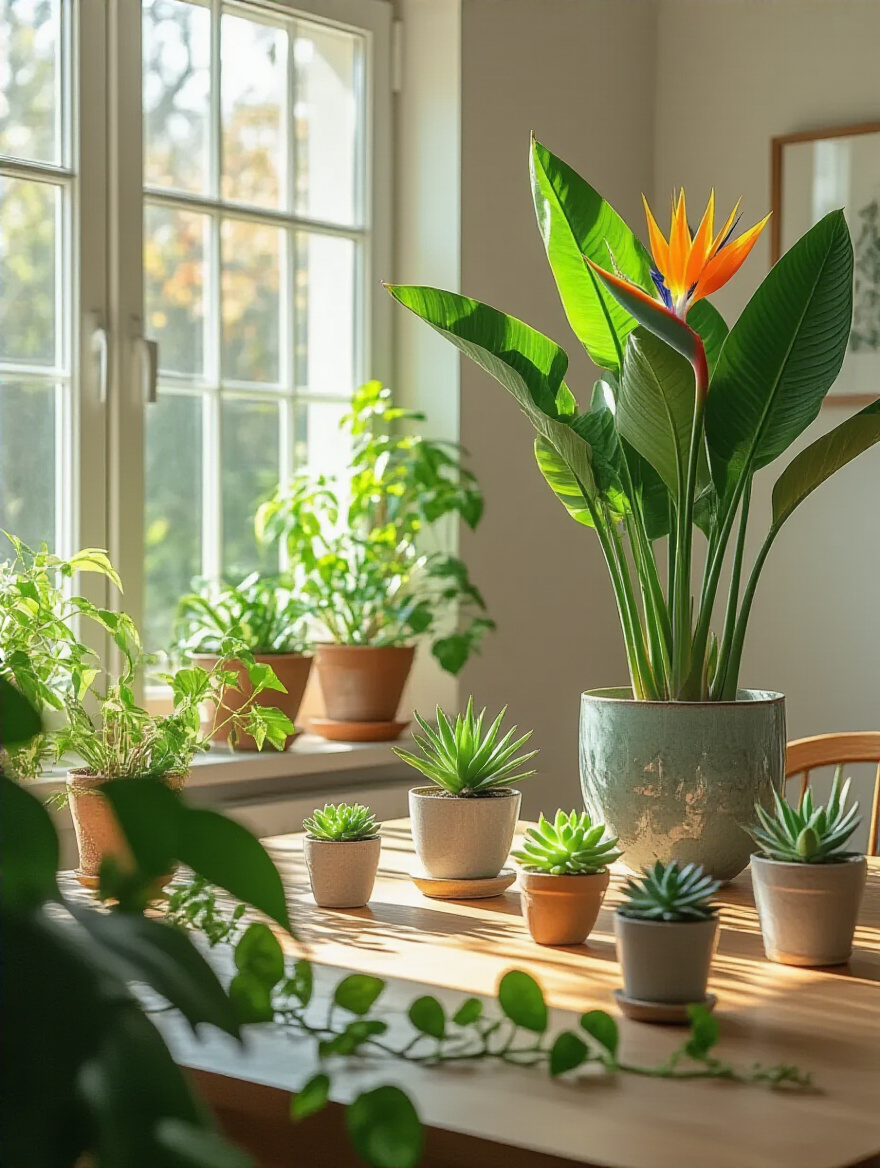
A tall, sculptural plant in a corner, like a fiddle-leaf fig or a bird of paradise, can add dramatic height. A small collection of terracotta pots with herbs on a windowsill adds a rustic, charming touch. A trailing Pothos on top of your sideboard will soften the lines of the furniture. Choose plants that work for the amount of light your room gets, and don’t forget a beautiful pot! The pot is like the frame for your plant—another opportunity to add color, texture, and style.
And for the final, delicious detail…
23. Curate Dinnerware and Linens to Elevate Every Meal
The final touch in creating a truly soulful dining experience happens right on the table. The plates you eat from and the linens that you touch can transform a simple meal into a special occasion. You don’t need ridiculously expensive, fine china that you’re afraid to use. Invest in a set of beautiful, durable everyday dishes that feel good in your hand.
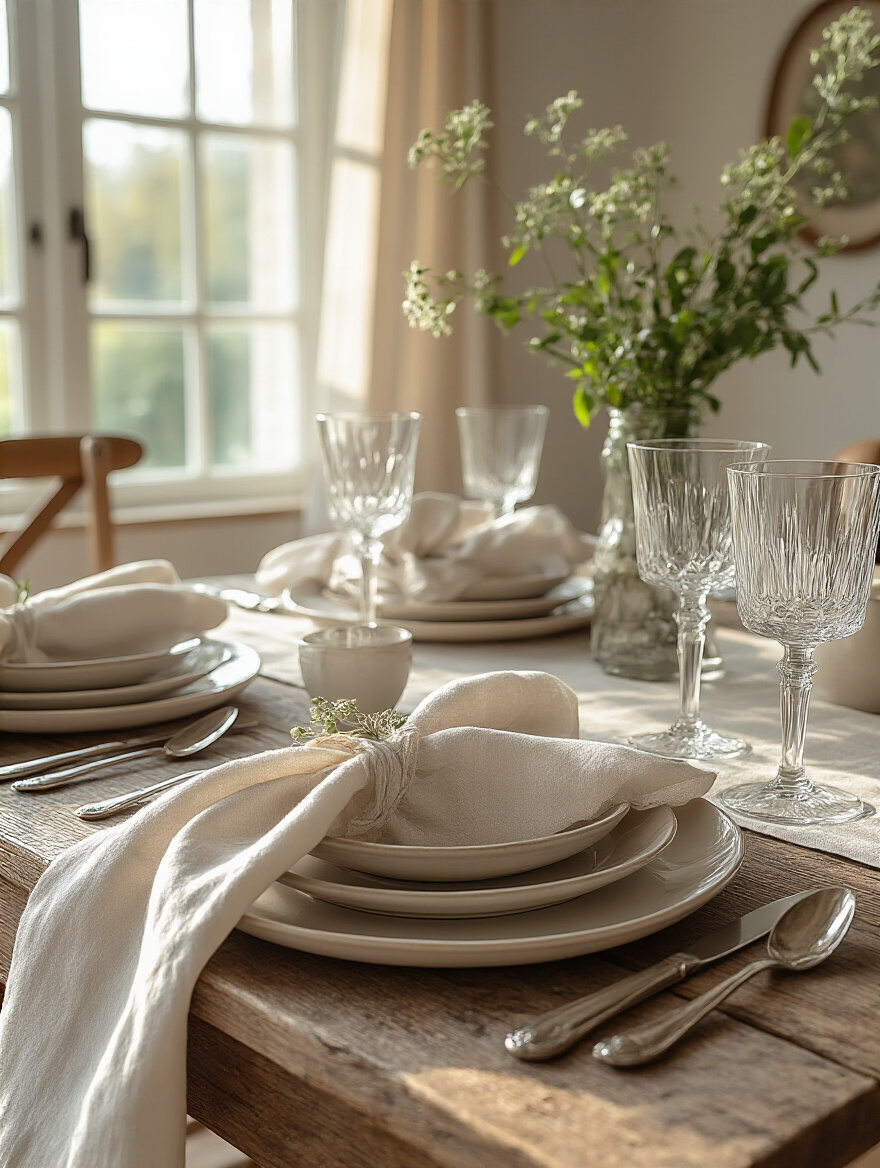
But this is where you can have fun layering. Mix your simple white plates with colorful, block-printed napkins and placemats. I love using rustic, hand-cast Kansa (bronze) serving bowls and platters—in Ayurveda, they’re believed to have health benefits, and they add a warm, earthy glow to the table. This mix of modern and traditional, refined and rustic, is what makes a table setting feel personal and inviting.
A Final Thought from Me to You
See? Creating a dining room that’s bursting with life and personality isn’t about following a rigid set of rules. It’s about listening to your heart. It’s about bravely choosing that splash of saffron yellow, honoring your grandmother’s lamp, and filling the space with objects that tell a story—your story.
Your dining room should be a warm embrace. A place that feels as good as the food tastes, as wonderful as the company you share. It’s where memories are made, where laughter echoes, and where connections are deepened. So go ahead, be bold. Be joyful. And create a space that isn’t just for dining, but for living, fully and beautifully.
